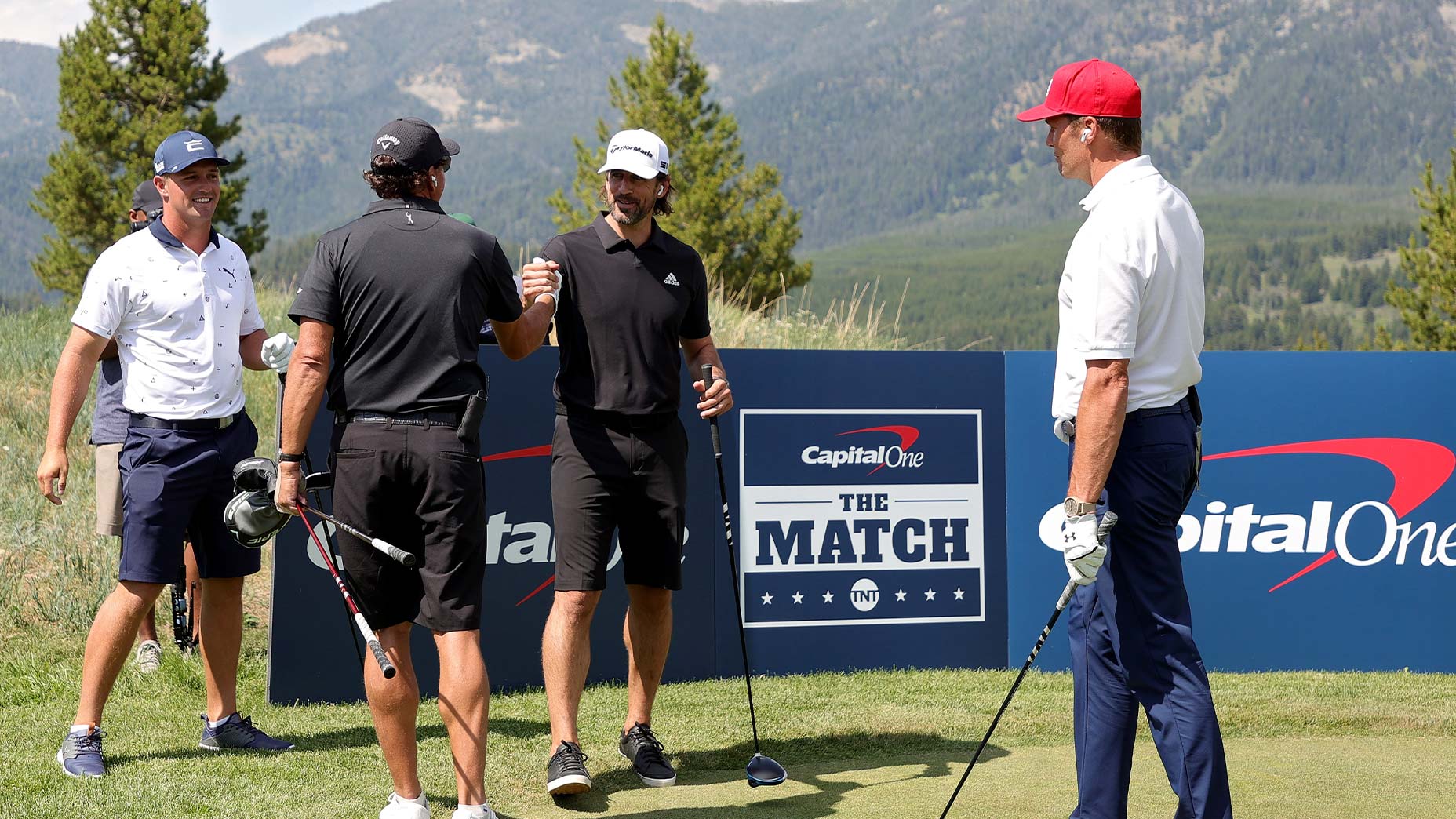Even if it’s corny, maybe this is all The Match is.
Maybe it’s nothing more than what we saw for four-plus hours on Tuesday evening at the jaw-dropping Reserve at Moonlight Basin. Nothing more than a gathering of celebrities at a golf resort in the middle of nowhere, where no element of showmanship and no depth of cringeworthy joke is too extravagant. Where the primary draw is the guys, and everything else is, well, secondary (the golf included).
Maybe The Match is nothing more than pure entertainment. Golf’s larger-scale version of the Harlem Globetrotters, or the Arena Football League. But in this contest, there are no Washington Generals, just a couple of Super Bowl-winning average joes — superheroes who masquerade as mere mortals away from their chosen specialty for long enough to (maddeningly) become more likable.
And who said there was anything wrong with that?
Rodgers and DeChambeau won 3 and 2, by the way. In a match that was light on well-executed golf shots, it was not DeChambeau but Rodgers who had the majority of them. During one stretch, Team Rodgers/DeChambeau used six of seven tee shots from the Green Bay Packers quarterback, who was a surprisingly steady counterpart even after Rob Gronkowski phoned in to tease him about the retirement rumors swirling around Wisconsin. At one point, the players competed to hit a 500-yard drive on The Reserve’s downhill 777-yard par-5. For added effect, the television crew had a giant white stripe painted across the fairway to indicate the 500-yard mark (neither pro came particularly close to hitting it, though Rodgers did crack 400 yards on his elevation-aided drive).
Former President Barack Obama joined the broadcast; later on, Obama was replaced by Cleveland Browns QB Baker Mayfield. Several million meals were donated to Feeding America, and several million dollars were donated to My Brother’s Keeper. But other than those very significant charitable acts, the result of the Match was insignificant. You didn’t care who won, and neither did they (well, maybe except for Brady) because it never mattered. Because the Match isn’t supposed to be about who wins and who loses.
Maybe we were wrong all along about what The Match was destined to be. After all, we’ve been wrong before.
We were wrong after the “original” Match — the Black Friday scrap between Phil Mickelson and Tiger Woods — when we began to dream of a future of highly competitive, highly visible matches between big-name talents. That match, the original, was a pillow fight billed as a title brawl. And yet with $9 million on the line, it worked, and so we believed in its potential to become something bigger.
We were wrong again after The Match 2. That wonderful, oddly thrilling battle at a rain-soaked Medalist between Tiger Woods, Peyton Manning, Phil Mickelson and Tom Brady. We were just happy to be there, clinging to a glimpse of normalcy after months of isolation — and they were happy to entertain. Two hours east of Disney World, it seemed a new category of golf television had emerged in much the same mold as the Magic Kingdom, lying comfortably somewhere between physically real and laughably outlandish. But what appeared to be a glistening light at the end of a dark, golf-less tunnel might only have been a mirage in the desert. A spark caused marginally by the product and overwhelmingly by the moment.
Perhaps the closest we came to understanding The Match before Tuesday evening came late last year, when Charles Barkley, Steph Curry, Mickelson and Manning played another event with far less fanfare. But even then, we were still wrong. The Match needs more than one professional golfer and fewer than three celebrity participants (if for nothing other than pace of play).
No, it wasn’t until we descended upon this match, The Match 4, that we began to understand what it actually is. It struck us like DeChambeau, who entered the course via helicopter. Like the talking goats (or is it GOATs?) who greeted us upon the start of the broadcast. Or like the impossibly gorgeous terrain that flooded every camera shot on Tuesday evening.
But even if the golf course appeared snatched from the annals of a John Muir novel, it could not distract The Match from its truest self: an entertainment product. The sort of thing that makes television executives happy, participants rich, and fans oddly placated, and that provides a glimpse into the high-world games played by the well-connected and well-endowed. It’s why the broadcast feels half-charity outing, half-red carpet show — because that’s precisely what it is.
It is not serious golf, as we had once thought. Nor a half-serious look into the games of the finest athletes in the world. It’s just fun, goofy, and occasionally corny. It might not ever be more than that, but maybe we should stop trying to make it that way.
For five hours on Tuesday night, a significant segment of the sports world turned its attention toward a golf event in a remote segment of the country. For a sport that obsesses over its growth and diversification, golf could do far worse for a Tuesday night in July.
Maybe this is all The Match is, and maybe that’s not so bad at all.
